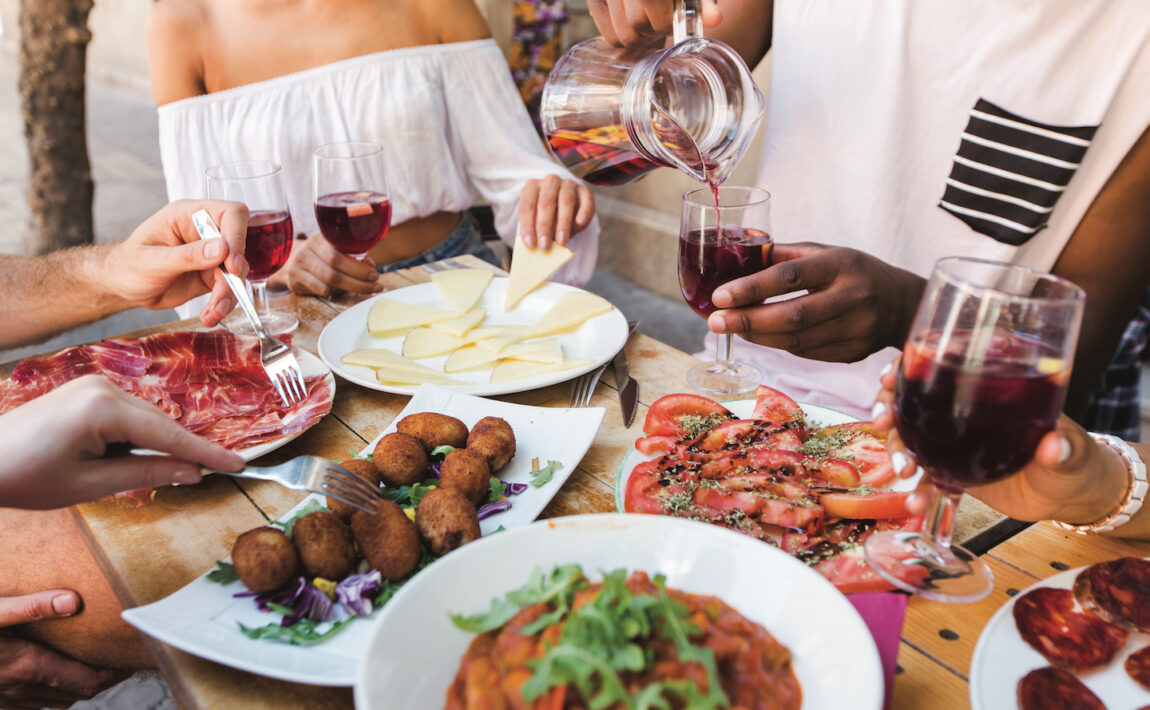In Spain, the most common way to eat (especially outside the house) is to eat tapas. Tapas are smaller portions of bigger meals, and are enjoyed by locals and tourists alike in every region around Spain, from the north of Spain like Bilbao, to the south in Andalusia.
What’s so special about eating tapas in Spain – whether at a tapería or restaurant, is that it is truly a unique and authentically Spanish way of having a meal and assimilating to local culture.
Many people may be confused about tapas: “What’s the point? They are just smaller portions of meals. Why not have one big meal?” Well, the reasons for this are to do with geography, culture and history, as well as many other sociological factors.
The history of tapas
The starting point of tapas in Spanish history is not known for certain, though there are several theories. One theory is that bartenders started putting a slice of bread, ham or cheese on top of their customer’s drinks so that small flies wouldn’t go into the glass. This would make sense because the verb “tapar” roughly translates to “to cover a hole”, meaning that “tapa is a “lid” in Spanish.
Another theory is that King Alfonso X of Sabio fell ill, and recovered by eating small portions of food with every glass of wine. He then made it illegal for publicans to serve wine without a small tapa on the side. Then, there are some theories that are a combination of the two. But don’t worry, regardless of where they came from, the culture of tapas is very much here to stay!
The different types of tapas
Tapas come in several different forms. In the north of Spain, you get them automatically and for free if you order a drink at a bar. They are usually small bits, like olives, toasted bread or jamón. They are called pinxtos.
In other parts of Spain, tapas are classified by the size of the portion. A medio ración is a larger portion, but still smaller than a full meal, while a tapa is a small amount. For example, for people who are used to eating one large meal at dinner, this translates roughly to three different tapas per person, or maybe a medio and 2 tapas. You can mix and match depending on how hungry or not hungry you are.
A tip: One method of learning more about tapas culture is to learn Spanish with a teacher who can tell you interesting tidbits of information and different Spanish facts.
Regional varieties
No matter where you go in Spain, you’ll most likely see the same tapas pop up throughout different menus, though local regions will have more regional and local variety than some of the bigger cities. For example, a popular tapa in the north of Spain will be fried chorizo in a small bowl, meant to be eaten with the bread that automatically comes to your table. This is because the north of Spain is famous for their cured meats like chorizo, salchichón and jamón ibérico, as the wetter climate means that pigs are grass-fed, and thus very tasty (sorry pigs!).
Seafood tapas are also very popular in Spain, and you can order tapas or racíones of gambas (prawns), calamari or pulpo (squid), or any of the local fish that the chef buys in the market that day. For vegetarians, the options are getting more and more plentiful. One of the most common tapas anywhere in Spain is the tortilla de patata (cold potato and egg omelette), croquettes de espinaca (spinach croquettes) or Moussaka (layered aubergines with béchamel sauce). Though Moussaka is a Greek dish, you will still find tapas of it in Spain, and in medio raciónes as well.


No Comments